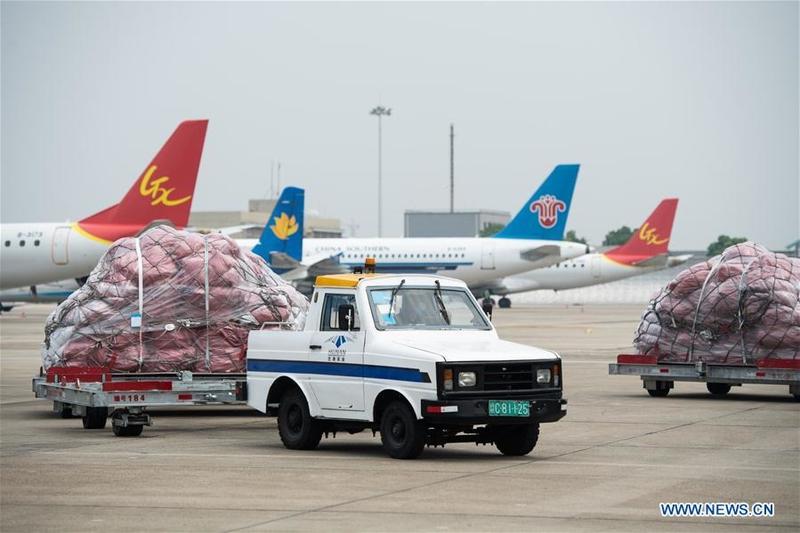 A tractor hauls the parcels from the cross-border e-commerce businesses to the parking apron at the Changsha Huanghua International Airport in Changsha, China's Hunan province, on May 28, 2020. (PHOTO / XINHUA)
A tractor hauls the parcels from the cross-border e-commerce businesses to the parking apron at the Changsha Huanghua International Airport in Changsha, China's Hunan province, on May 28, 2020. (PHOTO / XINHUA)
China's foreign trade volume totaled 11.54 trillion yuan (US$1.63 trillion) in the first five months of this year, down 4.9 percent year-on-year, according to data released by the General Administration of Customs on Sunday. The decline was the same as that in the January-April period, the administration said.
The country's exports increased by 1.4 percent year-on-year in May, compared with 8.2 percent in April, showing continuous recovery in recent months. But imports in May fell 12.7 percent.
The recovery in exports over the past two months was mainly driven by surging shipments of automatic data processing equipment and its parts, textile and plastic products, face masks and medical goods, experts said, urging the country's export-oriented companies to analyze global market demand during the post-pandemic era as soon as possible in order to remain competitive.
China exported 70.6 billion face masks, 340 million items of protective clothing, 96,700 ventilators, 225 million testing kits and 40.29 million infrared thermometers to over 200 countries and regions from March 1 to May 31, according to a white paper on the nation's battle against COVID-19 released on Sunday
ALSO READ: China's foreign trade to regain momentum in H2
Global market demand for ventilators, face masks, protective clothing and testing kits, which are urgently needed in the COVID-19 fight, was the main contributor to boosting China's exports of electromechanical, textile and plastic goods over the past three months, said Zhang Yongjun, a researcher at the China Center for International Economic Exchanges.
China exported 70.6 billion face masks, 340 million items of protective clothing, 96,700 ventilators, 225 million testing kits and 40.29 million infrared thermometers to over 200 countries and regions from March 1 to May 31, according to a white paper on the nation's battle against COVID-19 released on Sunday.
But shipments of other major exports such as furniture, clothing, shoes and automobiles all dropped notably in recent months, showing that the country's foreign trade still faces downward pressure, Zhang said.
Rather than cutting jobs and production capacity, Peak Sport Products Co, a sportswear company based in Quanzhou, Fujian province, joined hands with a number of international sports events and celebrities and used livestreaming to promote its latest sneakers and sportswear during the epidemic period.
"We have already adopted digital channels to boost the brand's influence," said Xu Zhihua, CEO of Peak Sport, adding that the firm has followed the actual demand of the global market and adjusted its product lines accordingly.
As a large number of economies have begun to resume production and services, exports of China's industrial goods and materials are expected to gradually recover, said Cai Jin, vice-president of the China Federation of Logistics and Purchasing.
China's exports dropped by 4.7 percent on a yearly basis to 6.2 trillion yuan between January and May and imports fell by 5.2 percent to 5.34 trillion yuan, the Customs data showed.
READ MORE: China pledges to ensure stable foreign trade, investment climate
China's foreign trade with the Association of Southeast Asian Nations, its largest trading partner, grew 4.2 percent year-on-year to 1.7 trillion yuan in the first five months of the year, while its trade volume with the European Union fell 4.4 percent to 1.61 trillion yuan and with the United States it declined 9.8 percent to 1.29 trillion yuan.
In addition to the China-Europe freight train service, the Haian logistics base of China Railway Shanghai Group Co, launched a freight train service from Nantong, Jiangsu province, to Hanoi in Vietnam on May 26 to export more than 70 containers of industrial parts, garments and photovoltaic products manufactured by companies in China's Yangtze River Delta region. It takes about 120 hours for the train to complete the 2,300-kilometer long journey.
The Chinese cargo train operator plans to run the train between four and six times a month to better connect the Yangtze River Delta region and the ASEAN markets.


